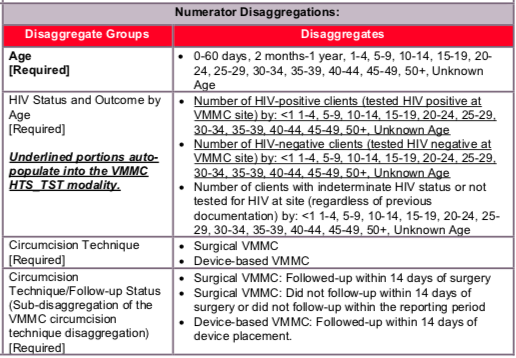(VMMC_CIRC) Number of males circumcised as part of the voluntary medical male circumcision (VMMC) for HIV prevention program within the reporting period
Export Indicator
This indicator tracks the number of male circumcisions conducted during the reporting period and assists in potentially determining coverage of circumcision in the population over time. The total number of males circumcised indicates a change in the supply of and/or demand for VMMC services. Additionally, disaggregations are required and are used to evaluate whether prioritized services have been successful at reaching the intended population (by age, HIV status, and circumcision technique), targets have been achieved, and whether modeling inputs should be adjusted. An additional level of disaggregation below the circumcision technique level is required for follow-up status, since post-operative clinical assessments are part of good clinical care and low follow-up rates may indicate a problem in program quality.
Number of males circumcised
N/A
How to calculate annual total: Sum results across quarters.
How to collect:
The numerator can be generated by counting the number of males circumcised as part of the VMMC for HIV prevention program. This information can generally be found in VMMC Register, or client medical records maintained by each program/site/service provider.
How to review for data quality:
Disaggregations for HIV status and outcome and circumcision technique should be equal to (but not exceed) the numerator. The circumcision technique by follow-up status disaggregate should be less or equal to the circumcision technique disaggregate.
Reporting Level: Facility
Reporting frequency: Quarterly


Disaggregate descriptions & definitions:
N/A
The numerator can be generated by counting the number of males circumcised.
Indicator changes (MER 2.0 v2.3 to v2.4): None
PEPFAR Support definition:
Standard definition of DSD and TA-SDI used.
Provision of key staff or commodities for VMMC include: medical instruments, supplies, or medicines needed for the VMMC procedure, or funding for salaries for HCW who deliver VMMC services.
Ongoing support for VMMC service delivery improvement includes: training of VMMC service providers; clinical mentoring and supportive supervision of HCW at VMMC sites; infrastructure/facility renovation; support of VMMC service-related data collection, reporting, data quality assessments (DQA); CQI/EQA of VMMC services at point of service delivery; or commodities consumption forecasting and supply chain management support.
Guiding narrative questions:
- Is the age distribution of males 60% or more 15+ years of age?
- Is this age distribution getting older as compared to previous quarters?
- If OU is using compression collar type device for VMMC
- Are they adhering to WHO Guidelines for tetanus immunization?
- Were there any tetanus AEs reported?
- What proportion of clients are returning for follow-up (should be at least 80%)?
- What barriers are there to further scaling up VMMC services?
Related Indicators
DfC.1 VMMC scale-up, 2020, WHO Consolidated HIV strategic information guidelines: driving impact through programme monitoring and management (https://www.who.int/publications/i/item/consolidated-hiv-strategic-information-guidelines).
3.17 Annual number of males voluntarily circumcised, Global AIDS Monitoring 2020: Indicators for monitoring the 2016 Political Declaration on Ending AIDS (https://www.unaids.org/sites/default/files/media_asset/global-aids-monitoring_en.pdf).